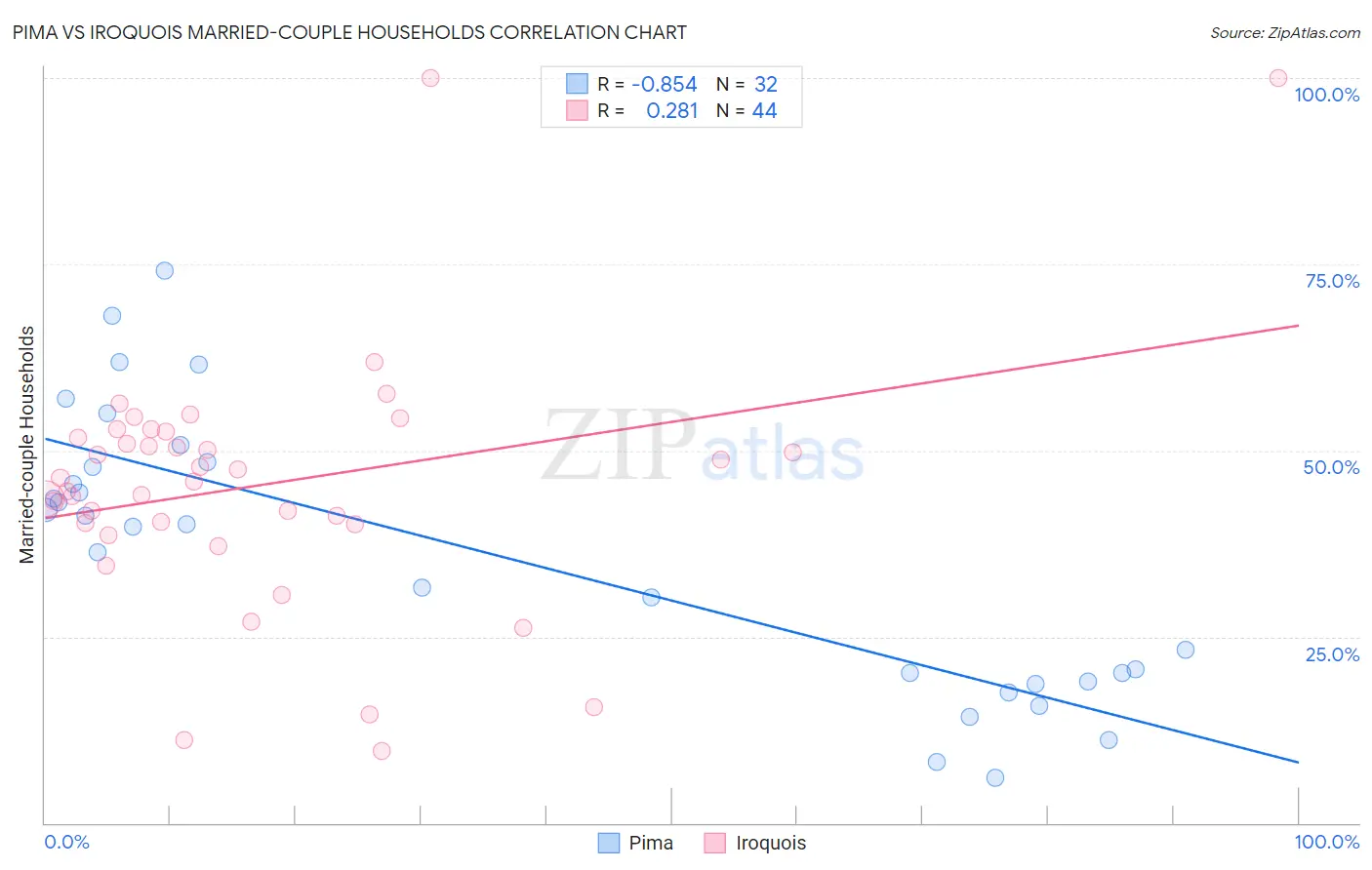Pima vs Iroquois Married-couple Households
COMPARE
Pima
Iroquois
Married-couple Households
Married-couple Households Comparison
Pima
Iroquois
35.6%
MARRIED-COUPLE HOUSEHOLDS
0.0/ 100
METRIC RATING
347th/ 347
METRIC RANK
43.7%
MARRIED-COUPLE HOUSEHOLDS
0.2/ 100
METRIC RATING
259th/ 347
METRIC RANK
Pima vs Iroquois Married-couple Households Correlation Chart
The statistical analysis conducted on geographies consisting of 61,538,795 people shows a very strong negative correlation between the proportion of Pima and percentage of married-couple family households in the United States with a correlation coefficient (R) of -0.854 and weighted average of 35.6%. Similarly, the statistical analysis conducted on geographies consisting of 207,249,804 people shows a weak positive correlation between the proportion of Iroquois and percentage of married-couple family households in the United States with a correlation coefficient (R) of 0.281 and weighted average of 43.7%, a difference of 23.0%.

Married-couple Households Correlation Summary
| Measurement | Pima | Iroquois |
| Minimum | 6.1% | 9.6% |
| Maximum | 74.1% | 100.0% |
| Range | 68.0% | 90.4% |
| Mean | 36.2% | 45.4% |
| Median | 40.0% | 46.1% |
| Interquartile 25% (IQ1) | 19.6% | 40.2% |
| Interquartile 75% (IQ3) | 48.1% | 52.1% |
| Interquartile Range (IQR) | 28.5% | 12.0% |
| Standard Deviation (Sample) | 18.4% | 17.2% |
| Standard Deviation (Population) | 18.1% | 17.0% |
Similar Demographics by Married-couple Households
Demographics Similar to Pima by Married-couple Households
In terms of married-couple households, the demographic groups most similar to Pima are Immigrants from Cabo Verde (36.2%, a difference of 1.9%), Hopi (36.7%, a difference of 3.2%), Immigrants from Dominican Republic (37.3%, a difference of 5.0%), Immigrants from Grenada (37.5%, a difference of 5.5%), and Tohono O'odham (37.9%, a difference of 6.6%).
| Demographics | Rating | Rank | Married-couple Households |
| Immigrants | West Indies | 0.0 /100 | #333 | Tragic 39.0% |
| Immigrants | St. Vincent and the Grenadines | 0.0 /100 | #334 | Tragic 38.7% |
| Senegalese | 0.0 /100 | #335 | Tragic 38.6% |
| Blacks/African Americans | 0.0 /100 | #336 | Tragic 38.5% |
| Immigrants | Somalia | 0.0 /100 | #337 | Tragic 38.4% |
| Immigrants | Senegal | 0.0 /100 | #338 | Tragic 38.4% |
| British West Indians | 0.0 /100 | #339 | Tragic 38.3% |
| Dominicans | 0.0 /100 | #340 | Tragic 38.2% |
| Cape Verdeans | 0.0 /100 | #341 | Tragic 38.1% |
| Tohono O'odham | 0.0 /100 | #342 | Tragic 37.9% |
| Immigrants | Grenada | 0.0 /100 | #343 | Tragic 37.5% |
| Immigrants | Dominican Republic | 0.0 /100 | #344 | Tragic 37.3% |
| Hopi | 0.0 /100 | #345 | Tragic 36.7% |
| Immigrants | Cabo Verde | 0.0 /100 | #346 | Tragic 36.2% |
| Pima | 0.0 /100 | #347 | Tragic 35.6% |
Demographics Similar to Iroquois by Married-couple Households
In terms of married-couple households, the demographic groups most similar to Iroquois are Central American Indian (43.8%, a difference of 0.030%), Blackfeet (43.8%, a difference of 0.070%), Immigrants from Cameroon (43.7%, a difference of 0.090%), Alaskan Athabascan (43.6%, a difference of 0.22%), and Ugandan (43.8%, a difference of 0.23%).
| Demographics | Rating | Rank | Married-couple Households |
| Seminole | 0.4 /100 | #252 | Tragic 44.0% |
| Central Americans | 0.3 /100 | #253 | Tragic 43.9% |
| Apache | 0.3 /100 | #254 | Tragic 43.9% |
| Shoshone | 0.3 /100 | #255 | Tragic 43.9% |
| Ugandans | 0.3 /100 | #256 | Tragic 43.8% |
| Blackfeet | 0.2 /100 | #257 | Tragic 43.8% |
| Central American Indians | 0.2 /100 | #258 | Tragic 43.8% |
| Iroquois | 0.2 /100 | #259 | Tragic 43.7% |
| Immigrants | Cameroon | 0.2 /100 | #260 | Tragic 43.7% |
| Alaskan Athabascans | 0.2 /100 | #261 | Tragic 43.6% |
| Vietnamese | 0.2 /100 | #262 | Tragic 43.6% |
| Cree | 0.1 /100 | #263 | Tragic 43.6% |
| Bangladeshis | 0.1 /100 | #264 | Tragic 43.5% |
| Moroccans | 0.1 /100 | #265 | Tragic 43.5% |
| Ecuadorians | 0.1 /100 | #266 | Tragic 43.5% |